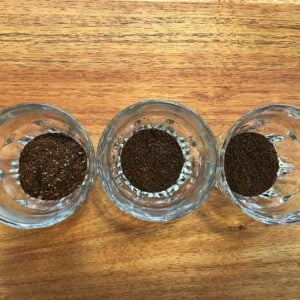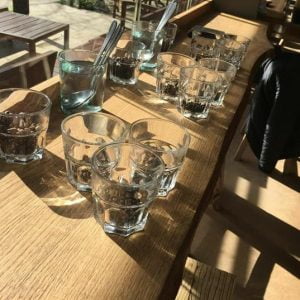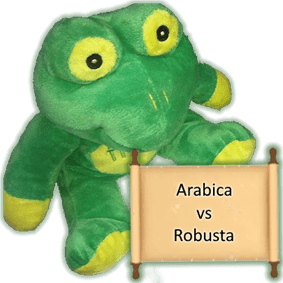Coffee soaked in Wine Experiment was done May-June 2017.
Why?
With us having a base on Buitenverwachting wine farm we had been asked the question a few times. We actually wanted to store green coffee in an old barrel initially. But one day we were asked yet again, and so we thought hell why not.
How?
We were given a red blend and aged white blend to play with. We decided to use a 2015 crop Burundi Kirundo Ndava Peaberry, which we really only use as a blender since it is old-crop.
Setup
We purchased some plastic containers that could be sealed and then measured in 500g of coffee and 600g of the wine.
Soak and Drain
We then let these sit for 48 hours tossing them once every 10 hours approximately.
After 48 hours we then drained the wine from the containers leaving only the soaked coffee beans. We had some loss of liquid (20-30mg), we believe due to evaporation that would have occurred and escaped when the plastic containers were opened. (Thanks to Dr N Marshall (a PhD in Chemistry) for clearing this up.)
Drying
Once drained we then placed them on top of an old hessian bag, inside plastic containers with holes. Thereafter they were exposed to sunlight under a patio roof for just over 7 days. At the end of the day, we tossed and covered the coffee with another hessian bag. In the morning we removed the cover tossed the coffee and left the cover off for the day. We repeated this for a full week and half a day.
Roasting
We then removed the coffee from the drying table let it sit for a day in the closed plastic containers, and roasted them the next morning in a Diedrich IR2.5.
Tabular Results
Summary of weights follow:
| Type | Weight in | Weight out | Weight after drying | Weight after roasting | Roasting notes |
| Plain coffee | 500g | n/a | n/a | 434g | Total: 5:41; first crack: 5:09 |
| Coffee in white wine | 500g coffee + 600g wine | 949.3g beans, 126.2g in liquid | 534.6 g | 441g | Total: 7:01; first crack: 6:14 |
| Coffee in red wine | 500g coffee + 600g wine | 934.4g beans,
151.8g in liquid |
537.2g | 443g | Total: 7:12; first crack: 6:12 |
What?
What was the result? For us the old crop coffee actually turned out to be okay then after that, the white wine was the most successful. The red wine-soaked coffees were totally overpowered by red wine. The White wine seemed to move the tastes further along the tasting wheels complexity to the cocoa and chemical tastes the red wine coffee was off the tasting wheels chart.
See summary below:
| Plain | White Wine | Red Wine | |
| Dry Aroma: | Med intensity | Med-High Intensity | High Intensity |
| Wet Aroma: | Brown spice | Brandy/Christmas pudding. Cherry casks | Beef stew in red wine jus. Black cherry liquor |
| Flavours at 80°C | Brown spice and dried peach | Fruit sweetness and dark chocolate | Furmenty, red wine-based beef stew |
| Flavours at 40°C | Black cherry and choc | Dark chocolate | Red wine acidity dominance. |
Espresso notes
We did make espressos with the coffees after, using a dose in of 18g and out of 32g. The plain coffee has great body and intensity, and almost no past crop taste. We, however, had problems getting a great pour from the other coffees even with the grinder set to its finest (we used a calibrated Vario grinder – see video below). But what we did get was not very enjoyable.
How we calibrated we calibrated a Vario grinder.
Note: no high quality coffee or wine was abused in the process.





